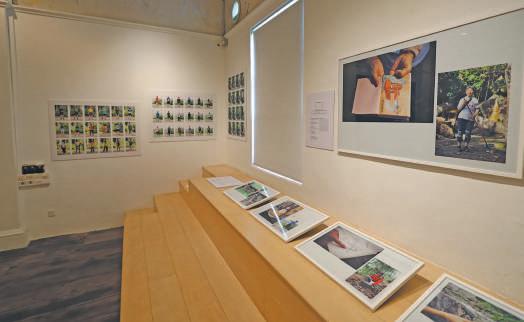这座城市留存多少文字?























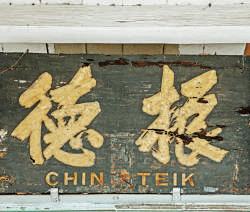




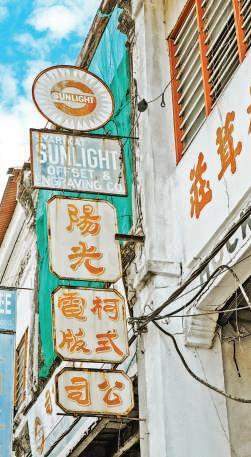







George Town Lifestyle and Culture
城视报创刊于2014年5月,每三个月出版, 是一份由写作人、设计师及摄影师等人共同编制的 社区画报。可在乔治市一带的咖啡馆、餐厅、书店、 民宿、主题馆、人文空间等地方免费索取。
召集人 黄伟益 出版总监 庄家源
主编 张丽珠
编辑 徐秋雁
采访撰文 徐秋雁 | 赵慈宇 | 曾瑞涓
特约作者 Evelyn Teh | Wan Atikah bt Wan Yusof
摄影 谢丽萍 | 李欣蔚
设计 李欣蔚 | 谢丽萍 实习 曾瑞涓
Special Thanks
亚洲文件夹集团主席拿督林顺发 赞助本刊全部费用
Printed by Asia File Products Sdn Bhd 16, Kawasan Perindustrian Bayan Lepas, Phase IV, MK12, Bayan Lepas, 11900 Penang, Malaysia
Published by 黑土设计所

Heitu Design
COEX @ Kilang Besi 123, Jalan Timah, 10150 George Town, Penang.

绘广告、再演化成立体亚克力字、千禧年开始通用的电脑字,通过匾
额、路牌、指示牌、看板等载体,无一不述说着社会的进化变迁。
Contact
+6019 472 6525

cityeyepg@gmail.com

说故事。这些遍布老街上的文字,覆盖了书法字匾额的岁 月,外加文字店招的崭新,它们周而复始,新旧交融,成为乔
著作权所有,
本社区报图文非经同意不得转载或复制。
撰文:徐秋雁 曾瑞涓 摄影:谢丽萍 李欣蔚
照片提供:受访者
走在大街小巷,迎面而来的不同年代招牌,除 了是店家组织机构的名号,它更是输送城市历
了是店家组织机构的名号,它更是输送城市历 史与记忆的注脚。从书法字、
绘广告、再演化成立体亚克力字、千禧年开始通用的电脑字,通过匾 额、路牌、指示牌、看板等载体,无一不述说着社会的进化变迁。
李树枝博士,记录 与研究
中国南来书法家的 墨迹,
将文字痕迹刻画在建筑上,还有年 轻字体设计师对字型的观察与探 讨,为大家解字



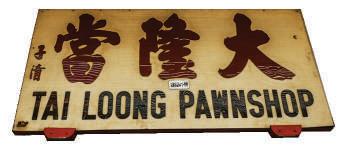



月,外加文字店招的崭新,它们周而复始,新旧交融,成为乔 治市的容颜。
上世纪开始一直到七十年代,槟城出现大规模的中国近代著名书画家南 来潮,因而在此留下许多墨宝。除了在纸画上,这些墨宝也遍布在公冢、会 馆、庙宇、学校等附近的街招、石刻、木匾上。由于牌匾年代久远,加上民 众没有保存文物的概念,文物皆被丢弃、烧毁及压毁。所幸经文史工作者对 这文化遗珠进行抢救,部分牌匾透过影像和文字被保存下来,也让世人得知 这背后蕴藏着的一段段时代故事。
槟城华人史研究学者张少宽,自七十年代初开始, 长期致力于槟城史料的搜集工作及实地田野调查,其 中包括公冢与家冢、寺庙碑铭、木刻、铜器及宗祠与家 庙资料。张生博学多才,并且擅诗词书法,因为对书法 的热爱以及自觉记录槟城牌匾的重要性,他展开了对 墨宝的史料考证和保存工作,2017年出版的著作《槟榔 屿翰墨缘》,便是对中国一代书法家南来槟城留下的墨 宝汇集。
问及张生如何查证墨宝的历史,他表示是透过老 师管震民和林千石、槟城艺术协会会长骆清泉及来自 中国、台湾的艺术家取得重要的史料,如获得纸本资料 或口述资料。
张少宽长期致力于槟城史料的搜集工 作及实地田野调查,出版多本有关槟 城华人史著作。
中国书法史上最重要的两种书体分为汉碑和魏碑,汉碑为隶书,魏碑则为楷书。张生提及最 好的书写境界,便是历代书法家所推崇的、南朝时期书法家陶弘景的楷书作品《瘗鹤铭》。一般而 言,商铺招牌字体要求端正平稳的字,寓意求得常年平顺的生意,本地的会馆、学校等牌匾字体多 为工整的楷体。
本地最标志性的牌匾书法,出自50年代南来槟城的两位碑学高手孔翔泰和崔大地的手笔。 孔翔泰的字求其逸放,从字体结构看得出有《瘗鹤铭》的书法意韵,深得商家们的喜爱,并将之视 为“福相”的字体。崔大地的字早期受《泰山石刻金刚经》影响,其中“大世界”咖啡店招牌写得甚 好,张生很是欣赏。不过,崔大地的字体不如孔翔泰端正平稳,左右不对齐而显得“老气横秋”。

民国四大书法家之一于右任(1879-1964)尤擅草书,首 创“标准草书”,被誉为“当代草圣”。他的书法造诣 极高,北碑南帖,汉隶章草均有涉猎,尤其在魏碑中融 入行书和隶书的笔意,形成独特的书风。
国民党元老胡汉民(1879-1936),广东番禺人,他好隶 书,亦擅长行书,是民国四大书法家之一。1921年胡汉 民赠送新加坡番禺会馆“番禺会馆”这四字墨宝,后来 马六甲、吉隆坡、怡保和槟城的番禺会馆皆复制相同的 匾额。


著名书法教育家李健(1881—1956),著有《中国书法 史》、《书法通论》、《金石篆刻研究》等书法教材专 著。他的书法从魏碑脱胎而来,是北魏书法界高手,流 传在槟城的墨宝剩下两处可见,一是汕头街“丽泽分 校”的旧校址,二是白云山的“福建公塚”。



张生提及大量的著名书法墨宝都出现在阿逸依淡(Ayer Itam)极乐 寺,其中登岩长廊旁的岩石上就刻有康有为的墨宝。当时康有为受住持妙莲

大师的邀请,当场题了“勿忘故国”四字。不仅如此,作为末代皇帝溥仪的太 傅——陈宝琛的墨宝也收藏在极乐寺天宫坛中,而收藏他最多作品的则是 福建公冢。中国一代书法家李健,即上海著名书法家李瑞清(清道人)之姪的 墨宝,也可以在前身为丽泽分校的建筑和福建公冢找到。
提及书法家崔大地的墨宝,张生表示由于骆清泉很欣赏崔大地的书法, 所以资助惠安公会买下他的作品来收藏。张生也分享,座落于霹雳律的槟城三 省堂龙山派曾公司已有145年历史,里面收藏了些许从马六甲带来槟城的古 旧墨宝。
“书法家状元”梁耀枢(1832-1888)为广东最后一位状元, 为官清正廉明,人品学识兼优,处事谨敏,深为两宫太后的赏 识和重用,称赞他为“金玉君子”。梁耀枢擅长书法,字体端 庄秀雅,不少书法作品被复刻成题匾或牌匾,作为珍藏之物。
静观池水知鱼乐 闲弄庭花好鸟啼
孔祥泰书法作品《七言联句》
图片来源:《中国南来第一代书法先驱大展集》 刘庆伦主编
槟城著名书法家孔翔泰,其书法被尊 称为“槟城体”,乔治市一带不难发 现孔祥泰所题之招牌匾额。

老教育家也是著名书法家孔翔泰(1896-1969),1926年南来槟城,在教育界 服务近四十年。他教育与书艺并重,孔氏书法深受北马人喜爱,人品和书品 同样端严精劲,与拿督沈慕羽被誉为“南沈北孔”。



对于张生来说,牌匾对史学的意义,主要是查证文人、革命家等到来槟城 的重要文物。从会馆和庙宇里收藏的墨宝,也帮助史学家了解该会馆和庙宇的 主要功能、创建年份、捐款名单记录、所供奉的神明等。在维护墨宝文物,张生 坦言自己年轻时做了很多田野调查和资料整理,如今年事已高,他主要是为年 轻学者提供协助,如给予纸本资料和多年累积下来的史料手稿。
不过,现今人们对华人民间文化知识仍相当匮乏,不免会出现破坏或烧 毁碑铭和牌匾的行为,这是张生感到最为惋惜的情况。他一再强调,只要是有 历史价值的墨宝,尽管无法做到将原物保留,但只要能拍照记录,就能够将之 永久保留下来。
中国南来马新的书法家孔祥泰和崔大地同样钟爱魏碑笔法,两位名家在马新两地 留下不少魏碑墨宝。北魏书风尤其盛行于北马,特别是槟城。崔大地曾旅居槟城15 年,本地著名书法家陈健诚就读新加坡南洋大学时期曾向崔大地学习书法。李树枝 博士为拉曼大学中华研究院中文系助理教授,2021年底,陈健诚与李博士合写论文 《南来书家崔大地:身世、迁徙槟城及其槟城公共场所书法文物遗产》,内容包含崔 大地1950年至1965年间的槟榔屿行迹及书法墨宝文物资料,解析崔大地的多体书写 风格。
商号墨宝
这四字应汲取《好大王碑》笔意, 凝练厚重,方整均匀。

崔大地生于1903年,凭其精湛的 甲骨文、金文、石鼓文、隶、真、行、草 各体书艺和融汇各体的造诣及书写 实践,成为中国南来著名书法家。崔 大地约于1946年抵达新加坡开书法 展,1949年到过吉隆坡、槟城、怡保等 地举办展览,并于1950年旅居槟城约 15年,直到1965年迁徙至新加坡。崔 大地在抵达槟城前后期受到槟城陈 诗畅与骆清泉等人的协助与接待,开 展了“以笔会友”的槟城旅居生活。

圆柱上“仰生皮料行”五字可见 崔大地的隶体亦融入楷体的笔 意,并能加以变化之笔意。此 外,“仰生皮料行”五字的笔意 亦可看出崔大地应取法自《爨宝 子碑》与《爨龙颜碑》的笔意。

本地书法家陈健诚(左)是崔大地的门 生,带着李树枝博士一起进行崔大地的 书法文化遗产研究。
中国书法讲求“书如其人”,崔大地既能奠基传 统且能按个别书体的书写特点之余,又能汇通各种 书体,呈现他具有个人特色的个别书体及融汇多体 的“崔体”的创新书体。
李博士的论文里也提到陈玉佩所述,“魏碑笔 法参合草书、魏碑融合隶书或汉碑魏碑结合,都是 崔氏在尝试创新中最为成功的作品,体现端庄、丰 腴、温雅三大特征。这是崔氏孜孜不懈地往深层次 去追寻整合的成果。”

这四字充满了隶体兼容章草的笔意, 呈现出了崔大地动态的隶书笔意。
50年代崔大地刚抵达槟城时,经常为槟城商 家书写匾额或宝号招牌,从中赚取笔润维持生活, 他书写的匾额有“惠安会馆”、“慕韩别墅”、“同善 学校”、“北京酒店”、“华都酒店”等。这些商号、会 馆等牌匾主要取法《北齐泰山经石峪金刚经》、《爨 宝子碑》、《好大王碑》等,以隶体为主且融合其他 书体笔意。

槟城坊间称崔大地的书体为“崔体”,乔治市 一带多处可见他写的横匾招牌或对联。据张少宽在 《槟榔屿翰墨缘》指出,崔大地的字迹保留得最 “精”的当数惠安公会牌匾,因为是时任惠安公会 会长骆清泉亲自监工崔大地的匾额题字。会馆的 文物木雕,尤其是崔大地的作品,都得经过骆的监 工精刻。

学校墨宝
同善学校


“同善学校”四字以隶书为本而又能 稍加以变化之,笔势圆浑厚实,韵含 金石味。

“时中分校”应亦取法《北齐泰山经 石峪金刚经》,结体宽博疏朗,静穆 平和,笔画呈动感,韵含金石味。
外门上“惠安公会”,内部“惠雨 安澜”两个匾额皆以篆隶体式书写 并融入钟鼎笔韵。
笔意取法《北齐泰山经石峪金刚经》, 用笔圆润厚重,雄浑朴茂。
崔大地应师法东晋的《好大 王碑》的隶篆之间的运笔, 呈现出朴厚古茂、均匀遒 健、雄壮浑厚的书写特点。



“槟城旅业公会”六字为章草书体, 呈生动姿态。
感谢李树枝博士授权论文《南来书家崔大地:身世、迁徙槟城及其槟城公共场所书法文物遗产》作为内容参考,并提供墨宝研究图片。




她说,走在槟城街上,各式风格招牌映入眼 帘,大至店家匾额、小至路边标志, 像是听到各种声音划过耳边。
有操着British口音的外 国佬说着怪腔的马来 文,有当地安娣用 福建话说的安全 提醒,也有年过 半百、风韵犹 存的女子在美 发院前,抛着 媚眼说“进来 呀”,还有唱歌 时常走音的大 叔,一幅幅的招 牌字幻化成街上的 声音,待你入店聆听 招牌后的故事……
这家“大信当”当铺招牌和圆柱商 号概括了中文、英文、爪夷文和淡 米尔文,彰显多元风情。
Sueh Li是字体专业出身, 喜爱到街上观察字体,看见 好看的字体就停下来拍照。



字体设计师Tan Sueh Li,是本地字体爱好者 团体Huruf的主理人,最大的兴趣就是顶着大热天, 在街上搜集让自己心动的字体。毕业于荷兰海牙的 皇家艺术学院 Type&Media 字体专业,留学回来后 长期在吉隆坡与马六甲工作。在槟城大山脚土生土 长的她,见尽他州的繁华,今年初带着期许回到槟 城,想在一段段街道找寻属于槟城的字。

呐,现今满街跑的绿色送餐摩托车Grab,就是 Sueh Li和朋友一起完成的作品。“当时刚从荷兰回 来,刚好遇到这个机会。因为Grab是从grab taxi起 步,我们就以马路的双线作为灵感,制作一系列字 体。”Sueh Li深知字体设计这行业在马来西亚较为 冷门,她坦言中文市场比英文市场更小,因此她接 获的案子多数是拉丁文字体设计。
字体爱好者团体Huruf本着在马来西亚推广字体 研究,在疫情期间,Huruf连同26位设计师进 行“Gotong-royong”线上设计活动,合力设计出融 合马来西亚元素的26个英文字母,供人免费下载。

旧招牌因为尺寸太大不符规定而被迫拆下, 老板干脆自己画个新招牌。
����既Penang!
作为一个造字者,对她来说,字是声音的形状,是无所不在的,望着招牌上的字,仿佛可以听到时代的 声音在耳边回响,有些是沧桑的,有些是轻柔愉悦的。马来西亚的多元化,造就我们独特的说话方式,一句 话可以掺杂不同语言,而这多元现象也反映在招牌上,中文、英文、马来文、淡米尔文、爪夷文互相交错在不 同招牌间,乱中有序、参差不齐却又和谐。
在马来西亚还未独立以前,华人商铺的招牌多数只有单一语言。直到马来西亚独立后,为了突出马来 文的“国语”地位,政府规定商铺招牌必须加上马来文。招牌中常见偏窄长的英文与马来文字型,就是为了 将中文、英文和马来文三种语言挤进一块招牌而形成,竟也成为一种特色。
槟城和吉隆坡是Sueh Li最熟悉的两 个地方,相较于吉隆坡,她认为槟城保留更 多殖民时期的招牌,在许多会馆、学校可以 看见上一代中国书法家留下的墨宝,还有 不少好看的手绘招牌,“也许是家乡情怀的 滤镜,我觉得槟城的招牌看起来比较有温 度。”她续说,吉隆坡很多是新旧招牌兼用, 因为华人忌讳随意摘下旧招牌(寓意关门 大吉),就直接把新的招牌和旧招牌并排在 一起。
Sueh Li在搜集字体时,也会走进店 里与街坊闲聊,了解招牌背后的意义。她分
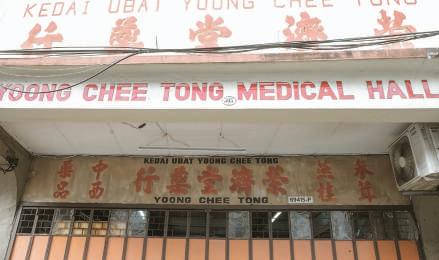
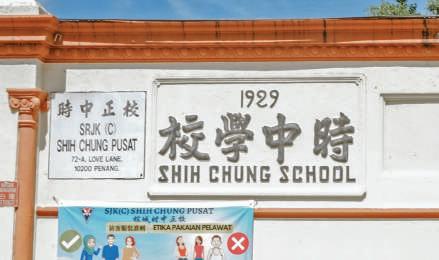

享道,在众多行业里,当铺和药材铺的招牌 是拥有最多语言的,招牌里一定有中文、英 文和马来文,有时还会加上淡米尔文。仔细 观察,可以发现当铺招牌以中文字占最大 比例,这是因为从前低下阶层多数是华人。 有趣的是,有些商铺还会加上绘图,就像帆 布店的招牌绘上帐篷,有些则在招牌两旁 直接写上店家提供的服务或商品名称,这 家店卖什么看招牌就知道。
每个地方都有属于 自己的声音,招牌会微 微反映出当地语言的变 化,就像槟城是以福建 话为主,可以看见许多 用福建话命名的招牌, 甚至是对“槟城”二字的 不同写法——有“庇能” (马来文)、“Pin Seng” (福建话)等等。
“字体设计不只是 重视字型的美,还有语 言的融汇,我观察到槟 城的特色还是以语言为 主,不同族群的人一开 口都是福建话,我觉得 很有趣,也希望从中探 讨些什么。”
新旧招牌摆在一起,你要从哪边读起? 用福建话英译的“Pin Seng”。 商铺招牌写有药行售卖的商品,一目了然。Gentle reminders from ah gong ah ma
Angmoh with British accent
Hiao-hiao seduction from sui cahboh
Sueh Li的《庇能说》是Huruf团队制作的《Still Typing...》
Zine系列之一,这本小书从工具、材料、网格、声音和语言 等各种元素去探索“字型”这件事。
 Karaoke singing from rukun tetangga aunty uncle
Kaki-lai spirit
Karaoke singing from rukun tetangga aunty uncle
Kaki-lai spirit
牌匾是书法和木刻的艺术结合,常见于会馆宗祠、 庙宇、公冢、商铺等,既是书法作品,也是文化的符 号。槟城书法家留下的墨宝,重点虽在真迹,牌匾雕刻 也应记一功。传统牌匾雕刻是书法作品的再现,雕刻木 匠必须拥有好的技艺,才能将书法家的书法精髓复制至 匾额上,保留至今。

牌匾雕刻在本地是一门重要的传统工艺,李德财是槟城目前少有的 手工雕刻牌匾匠师,并于2020年度乔治市世界遗产机构奖获得大师技艺瑰 宝奖。
67岁的李德财从事牌匾雕刻,也擅长古董木家具修复,是妥妥的手艺 人。他7岁开始和父亲学艺,学习雕刻与专研各种木工,至今已入行50年。他 2009年于打石街开设“德财木器”,每天早上开工在门外雕刻牌匾,总吸引路 过游客驻足观看,有不少中国、德国、加拿大、澳洲等外国游客订制他的手工牌 匾回乡。
李师傅从小并不擅长书法,早期他经常观

察街上牌匾书法,研究不同书法家的笔法, 多番熏陶下,后来他也自创别具一格的行 书书体。他表示从事牌匾制作的不一定会 写书法,但必须懂得书法的形体和笔意, 才能刻出书法的神韵。
李德财定期为雕刻刀打磨和 上油,刀利才能善其事。
李德财目前忙于这幅中国游客 订制的凸雕牌匾,凸雕比起凹 雕需时更长。
三幅皆是李德财作品,但三幅牌匾 的书体不尽相同,各有风格。



李师傅出身木匠世家,从小学习雕刻与专研各种木工, 不只是牌匾雕刻,他也擅长古董木家具修复。
一幅牌匾需经过打底、描稿、雕刻、打磨、上漆、安金等多道程序完成,

最快也需两个星期至一个月完成一幅牌匾,若是精匾则需时半年以上。李 师傅使用的是白蜡木,这款木板比较硬,较适合雕刻。牌匾雕刻可分为两种 刻法:凹雕和凸雕,底色多为适合家用或商用的黑色,寺庙用的红色,以及 少数的靛蓝色。李师傅强调最后的安金和扫金手法极其重要,他使用的是 99%纯金金箔而非工业金,因此匾额上的字看起来特别亮。
桌上逾20枝不同大小的雕刻刀,是他特别在中国搜罗回来的雕刻工 具,至今已用超过20年。每次用完工具后会打磨、上油,他表示工具长期 曝露在空气会氧化生锈,因此需定期保养。拥有木工底子的他,就连木 锤和刨木器都是自制的。
李师傅出身木匠世家,是家族第5代继承人,他遇上与其他老 行业同样的问题——无人继承衣钵。他不希望这门传统手艺就此 失传,有意寻找接班人传承下去,奈何十几年过去还找不到适合 的人选。
“这些年是有人来拜师,但他们只想要速成,刀还没握稳就 想学雕刻。要学好木刻需要好几年,从基本功开始学,这些都是学 问,急不来的。”若是遇上适合的接班人,李师傅也不吝于传授古 董家具修复技艺,等于是将一生手艺倾囊相授。但适合的人什么 时候出现呢?
除了大型牌匾,李德财也会制作小牌匾给游客选购。
匾 雕 刻 师 李 德 财
Asemic Calligrapher,向往成为一位刚柔并存的 艺术人,写/画会呼吸或能与观赏者说话的作品。
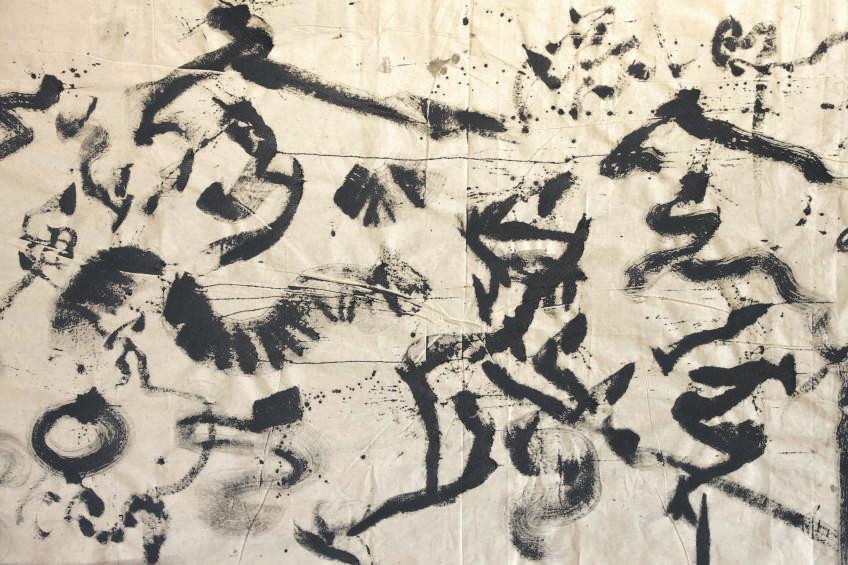
尺寸 | 100cm (W) x 150cm (H)

媒介 | Chinese ink on canvas
用心看,不带任何世俗的偏见去感受每一笔触和线条。思维越自由你越能看见其中之美。 它们能带给你许多想象,也可以只是一片随意涂抹。书法和绘画结合,一种千变万化的形
态,带给你字体以外的视觉感受和内心感知,这就是asemic writing 最有趣的地方。
创作时我会自然地处在一个孤独的氛围,这样的氛围让我萌生很多突如其来的灵感和觉 悟。 我很喜欢“sadness is a gift”这个说法,感伤对我来说是一种安全归宿感,必要的存 在。宁静的忧郁,欣然接受这世界没有什么能长存,没有什么是完美的,没有什么是完成 的,一种坦然的快乐。
我的作品都是我往内认识自己、聆听自己心声的投影,思想的觉悟和灵性的参透。他们承 载着无法归类的情感和成长过程中重迭的声音,是和过去和好的一种笔触发泄和释放。






2018年8月 / 售卖城视报团队的出版品及周边。
2018年11月 / 书摊加入读嚼兽书店的选书, 让更多书籍走进社区。
“岛读”起源于城视报2018年的一次企划,从岛读空间到岛读书店,一直围绕着阅读 这核心不断演变。而推动阅读的工作,其实在岛读这名字诞生之前已经悄悄开始。
城视报自创刊以来,通过出版和活动,尽力为在地人制作和呈现好的内容。那时我们 不知道这些单个小活动将发展到哪里去,只觉得人们值得优质的内容、优质的内容也值得 被更多人遇见。

2022年4月 / 位于民居的城视报 工作室,开放读者预约前来看书 买书。
2022年7月 / 开在Sixth Sense 服饰店,集合衣物、书、咖啡、 书法的9日快闪书吧。


2022年 10月 / 70多种杂志聚集在 新开放的文创园区COEX。
2022年 12月 / 杂志展漂流到吉隆坡和 居銮。



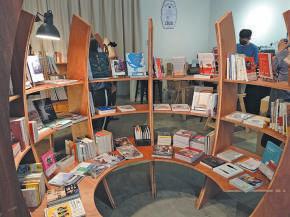

2019年10月10日 / 驻马台北经济文化办 事处捐赠金鼎奖获奖出版品,让读者有 机会接触优质书刊。

2021年4月4日 / 第一次参与周末市集, 与读者面对面交流。(图:KH Chang)
2021年11月2022年1月 / 书店 走出乔治市,快闪 柔佛麻坡REKAN图 书馆和加影般若人 文空间。
2021年9月-10月 / 乔治市艺术节岛屿岛 系列下,疫情后以全新形象回归实体。 岛 读 书 店 开 张
2021年4月24日 / 暂别实体空间,岛读转 向流动型式和线上。
阅读是一次次的发现、是一条条通往共鸣的道路,也是一场场脑内的旅 行,我们希望通过我们的工作,能让这些“发现”发生得多一点点。

我们相信一本本500克的标准书重量里装载着奇遇,也认为实体空间是 一个邂逅的平台,让人与人、人与书相互遇见,碰撞出更多思想的火花。

第一场小书摊距今已有5年,欢迎你继续见证岛读的演化。

2023
COEX, 123, Jalan Timah, 10150 George Town,Pulau Pinang.


周三至周日 / 12PM - 8PM

用电锤将铁条尾端锤 打成箭头形,再用锤 子锤打修飾外形。
店外传来叮叮当当铿锵有力的打铁声,悦耳的声响来 自已有百余年历史的德万春铁铺。槟城港口曾是许多舯舡 (Tongkang,大型木造舢板)选择停靠,进行物流转运的 物资集散中心,间接促成打铁业的兴盛。德万春第三代传 人张华源18岁开始跟父亲学习制造船用铁器及家用刀斧, 船锚是店内主要的船用铁器。


船锚的制造工序繁杂,最重要的是懂得掌控火候, 而过程中的锻打、穿孔、切割、弯曲及焊接等技巧也讲 究精准。随着集装箱运输方式和煤气的出现,船只和火 炭运输逐年减少,打铁业难复当年辉煌。如今,槟岛也 只剩这间铁铺和七条路另一间铁铺铸造船锚。

张华源依尺寸制作不同大小 的锚爪模具,让船锚制作更 方便。
张华源出身打铁世家,纵使 打船锚已是夕阳行业,他期 望这门手艺能够延续下去。

张华源的爷爷是客家人,祖辈们都经营打铁生 意,爷爷南下槟城后创立自己的打铁生意。爷爷一共 开了两间铁铺,一间位于牛干冬,由大伯经营,十几年 前就已停业,而这间位于本头公巷的铁铺则由张华源 的父亲经营,他22岁时接手老店,至今已53年。
他坦言,这是份辛苦工作,儿子无意继承生意, 他不强求;之前来当学徒的两位外籍员工学成后就 回国,他也不挽留。嘴上说着对手艺后继无人的坦 然,但神情不免流露出一丝遗憾。相比之下,市面上 那些现代化机械制作的船锚,质量和实用性都达标, 不过船锚的外表设计终究比传统的来得逊色,价格 也更昂贵。


50, Armenian Street Ghaut, George Town, 10300 George Town, Pulau Pinang.
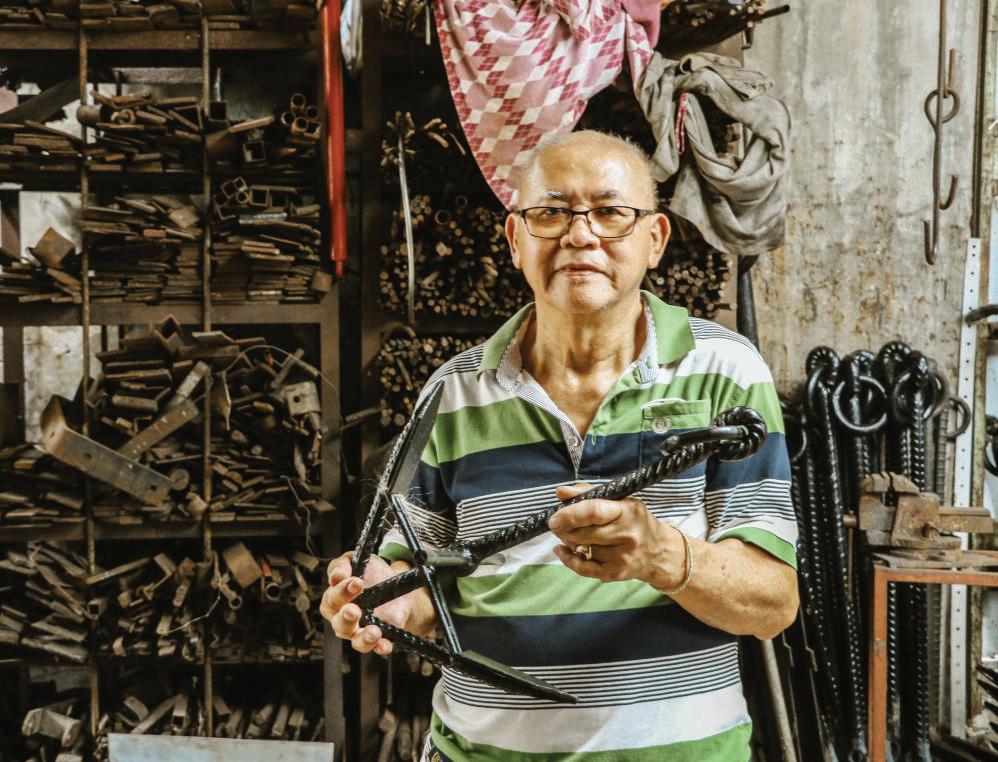
德万春铁铺历经三代,鲜艳的手绘招牌在本头 公巷老街特别显眼。
有了电锤,铁匠一天至少可以捶打100枝铁条, 比起手工捶打更省时省力。

张华源目前半退休,一般只在下午工作,早上至中午则由 头手(主将)黄亚成负责,以确保店内有足够的船锚组件。黄亚 成是店内唯一的头手,只见他在燥热高温的环境下从容工作, 直到午餐时间才停工休息。在槟城码头还未建造前,货船只能 在海中央停泊,由舯舡来回搬运货物,当时便有许多舯舡将泰 国的火炭运来槟城,加上本地渔业兴盛,店里曾有多达四至五 位员工工作,以便应付庞大的船锚需求量。
头手和二手(副手)根据客户所指定的船锚重量、长度等 将船锚各组件进行焊接。一般上,打铁需要两个人,即头手用小 锤打铁,二手则用大锤打铁,若是较大的船锚,如最重的300斤 就需要三个人才能完成。
张华源的父亲打铁年代没有电焊机,所 以需在各组件穿孔才能进行衔接,纯手工制 作船锚的过程比现在更辛苦。此外,靠人力 锤打铁条很费劲,制作小型船锚至少费时三 至四天,大的则要一星期的时间完成。
张华源继承手艺也改良手艺,如引进英 国和中国机械,大大提高工作效率。有了电 锤,一天要锤打一百枝铁条也没问题;可以 二十四小时运作的电焊机轻松解决衔接组 件的问题;切割器和砂轮机也加快切片和磨削的工作。
为了确保船锚弧度、大小统一,张华源亲手制作各款式的 船锚模具,自此制作船锚更方便,店内款式多样的船锚,都是张 华源认真设计和专研的成果。他表示,两个锚爪至五个锚爪都 可以供渔船和舯舡所使用,五个锚爪的船锚在沙石多的海域停 靠时更加稳固。



面对行外人,张华源毫不吝于分享各种船锚的用法和特 色,显现他对这份行业的热情仍未被现实所磨灭,把打铁视为 一辈子的志业了。
 刚完成捶打的铁条还带有烧红的痕迹。
刚完成捶打的铁条还带有烧红的痕迹。
将铁条放进火炉烧红尾端。
已穿孔的锚爪等着焊接。
一踏入槟城和谐中心门口,内有两座建筑物和一个大花园, 后花园紧邻一条小溪,被虫鸣鸟叫和潺潺流水声环绕着。由马来

高脚屋改装而成的独立建筑为槟城和谐机构的办公空间,另一
栋新建的民众会堂和后花园则开放予各个宗教团体及民众租借

举办活动。环境宜人的槟城和谐中心于2019年底建成,由槟城建
筑师陈美佑操刀。她也是第二期槟州数码图书馆的建筑师,以回
归原点的设计精神,保留老屋原有的结构,并让自然光渗透在建
筑物内,达到美感和节能的效果。
槟城和谐机构经理欧宗义说,中心成立 后,他们邀请了不同宗教组织使用这个空间, 没想到他们轮流使用一番后,世纪瘟疫便降 临。疫情中,宗教组织和官家缺乏桥梁的问题 更被放大。例如,虽然联邦政府为非伊斯兰宗 教场所制定了礼拜SOP,然而“非”这个字囊 括了伊斯兰教以外的许多宗教,其礼拜程序 也不一样,一套SOP并不能同应用在寺庙和 教堂,宗教组织却不知向谁反应、由谁处理。
槟城和谐机构通过举办跨宗教对话与 推动州内非伊斯兰宗教事务,期望将 槟城打造为和谐与爱心社会。

当时欧宗义正担任非伊斯兰事务委员会主席 章瑛的助理,他献议成立一家机构,负责执行非伊斯 兰组织之间的事务,作为宗教组织和政府、民众与其 它宗教组织的一个桥梁,也推动族群和宗教之间彼 此了解和认识。于是,槟城和谐机构在2021年成为 西马唯一有非伊斯兰事务执行机构的州属。

成立初期疫情仍严重,槟城和谐机构便在线上 通过照片、影片和文字推介槟城各个宗教场所。其中 包括北海和乔治市的和谐之路地图、锡克庙宇合集, 以及一些较具代表性的宗教场所介绍。此外,他们还 综合各方的记录,建立一个完善记录槟州非伊斯兰 宗教场所的电子平台eRIBI。此前,不同的宗教场所 都向不同部门申报场所资料,也没有相关的平台供 群众搜索完善的资料。
疫情放缓之后,和谐机构去年开始频密推出线 下活动,包括与华裔穆斯林庆祝农历新年、主题画 展,今年也和城视报共同推出一年六场“众神的花 园”印度庙导览团,从文化课程到庙宇导览,带领华 人实地认识印度文化,让“包容”不仅是飘渺的口号, 而是实在理解后产生的情感。
槟城和谐机构邀请华裔穆斯林举行新春团 拜,展现宗教和民族文化之间的多元性。 (图:槟城和谐机构)
“
地址 :15, Jalan Scotland, 10450 George Town, Pulau Pinang.



开放时间 :周一至周五 / 9AM - 6PM 电话 :04 - 226 1582
自然采光的设计,加 上木制家具,营造出 舒适的办公空间。
槟城和谐机构的团队目前只有8人,中间者 为年资最长的经理欧宗义、右二为年资最短 的专员徐伟升。(图:槟城和谐机构)

槟城和谐机构与民间庙宇文化普及团体“一庙 一路”合作,推出道教展览。
这些项目背后是一个年轻的团队——最年长的 同仁也只有32岁。这个团队年初增员后,目前也只 有8人,执行的计划却密密麻麻。槟城和谐机构的同 仁们的教育背景各异,从金融会计到人类学,共通 点都是活泼而充满激情的新世代。
采访后,新加入的社区协调专员徐伟升送我们 离开,并准备和同事们到外头踩点—— eRIBI并不只 是将各个系统上的资料整合便大功告成,也需要人 员到现场确认细节是否有误差,比如地址是否有偏 差、是否有未被记录的场所。
欧宗义和徐伟升都曾在联邦体制内当过公务 员,有感在这个新创机构里,能在一年内看见计划 成型,甚为快慰。这个幽美的环境除了孵化许多计 划,也是同仁们自我实现的地方。
“众神的花园”印度文化课程与庙宇导览,以 华文为媒介语,系统地为群众梳理、认识印度 教与印度庙的背景。

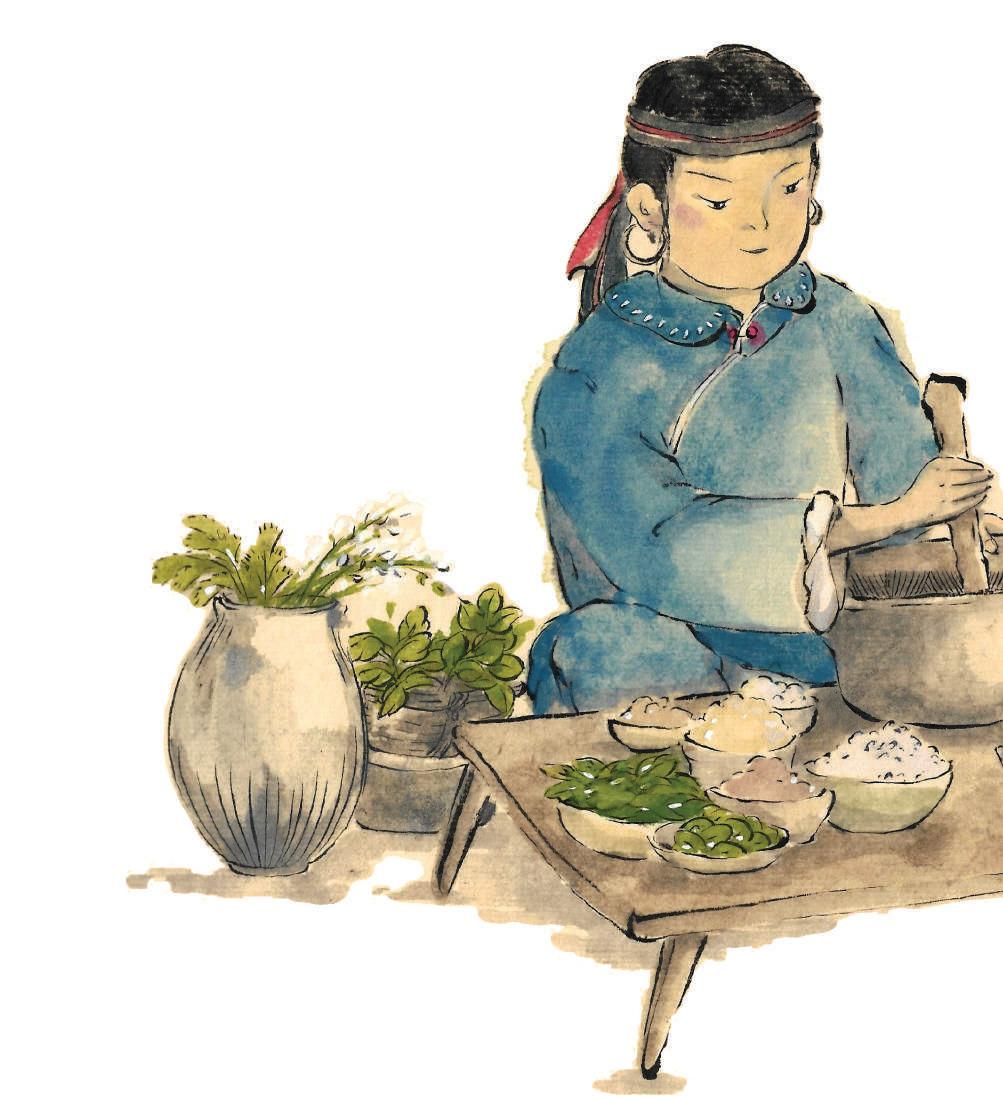
主讲人:张菁蓉,华侨大学华侨华人研究院硕士 文字整理:张婉芊 绘图:张桂佩

根据《都城纪胜·茶坊》记载,擂茶最早出现于南宋的茶坊,是普通老百姓的日常 饮食。擂茶是按其制作工艺来命名的,讲究“擂”的动作,即用擂棍将茶叶、芝麻、 花生等食材放入擂钵中擂碎至膏状,加水煮开来饮用,或煮成茶粥食用。配料各地 不同,有的会添加花椒、草药等,食材都可自己采摘。据说,擂茶是广东河婆镇的 老妇人何婆在街边售卖的小吃,“河婆擂茶”一名由此而来。但它在发展的过程中逐 渐消失了,惟有河婆客家人保留了下来。河婆客家人因战乱、饥荒等原因进行了五 次大规模南迁,去到福建、江西、广东等偏远山区,保持了擂茶古朴的制作方法。 随着他们南下至马来亚,其饮食文化也随之流动了起来。由于地理、人文和时代的 关系,擂茶的食材和其形式、制作方式有了新的变化。
南下的河婆客家人一般从事采矿、种植等苦力活, 为了满足高体力的需求而将擂茶搭配白饭来吃。随着经 济力量的增长,擂茶的原料开始丰富了起来,由花生、芝 麻、薄荷、香花菜、芫荽、树籽菜、苦粒心所组成,而擂茶 菜则选择带有香味而口感脆口的食材,譬如芥兰、韭菜 花、长豆、蒜。因地理和交通的关系,有些食材难以取得, 例如中国的芝麻,所以他们纳入在地食材如四角豆、胡 椒,创作出具有在地特色的擂茶。
一些河婆客家人会携带制作擂茶的擂棍和擂钵一 起移居至马来亚。但随着时代的发展,他们大多不再耐 心研磨擂茶的原料,而是将食材一鼓作气地丢进搅碎 机,擂茶的制作工艺面临传承的危机。因此二战后,河婆 客家人开始建立同乡会,组织各种活动来宣扬河婆客家 人的文化,而擂茶的推广必不可少。他们举办擂茶制作 活动,也举行各种与擂茶相关的演出活动,擂茶渐为人 所知。随着90年代健康饮食的兴起,擂茶被视为绿色健 康食品而越受欢迎。大马的河婆客家群体也从举办擂茶 品尝活动演变为大型擂茶大会。

如今,擂茶的样式更加多样化,如擂茶炒粉、擂茶披 萨、擂茶冰沙等,更推出便利式包装的擂茶食品。擂茶已 成为全球流通的食品,是一种兼具传统文化和商业价值 双重身份的常见美食。
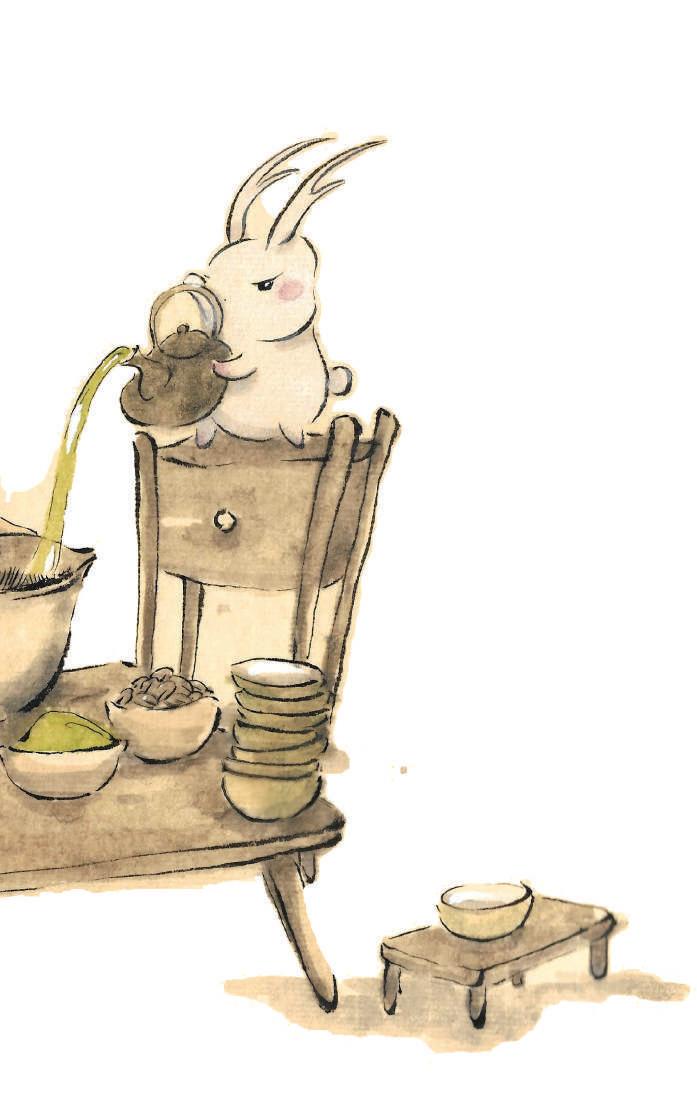

河婆擂茶是河婆客家人的代表性传统美食,象征他们淳朴、坚韧的精神, 它的传承与发展凝聚了多方面的力量。在大马,它是在族群文化、本土化和全 球化的相互作用影响下发展起来的,吸取了在地特色,成为一种多元文化性 的食物。不仅是饮食的融入流传,更是一种在地的创新与发展。例如,受到环 境因素的影响,擂茶拥有了地域性的发展特色,这可从东马和西马两地的擂 茶上发现。西马的擂茶因添加了树籽菜、包菜,味道较甜,东马的擂茶则较为 传统,入口浓苦。

河婆擂茶经过飘洋过海的奇妙之旅,有了许多新的发展与变化。早期的 河婆客家人、经济力量处在极其边缘的位置,社会地位低下,其饮食文化仅流 传于自身家庭中,外人甚至很多客家人都不知道有擂茶这一饮食。来到了七 十年代,它也只是一种果腹的庶民小食。
但是,随着河婆客家群体势力的壮大,擂茶逐渐被整个客家族群看见。 擂茶开始走出河婆客家人的家庭饮食的范畴,发展成一种象征族群意象的载 体,进而发展成为客家人的代表性食物。擂茶跨越了更远的边界和更广泛的 交流,成为全球客家人超越时空与空间、相互交流与联系的共有饮食文化, “河婆擂茶”的名称也随之演变为“客家擂茶”。

从“河婆擂茶”到“客家擂茶”


 Text & Photos by Evelyn Teh
Text & Photos by Evelyn Teh
Roughly three years ago, the world descended into a prolonged lockdown to stop the spread of the Covid-19 pandemic. To make the most of our time staying indoors, many of us explored new things to do. So, when there was an announcement of funding for social documentary film proposals, I took it as a challenge to try something new myself.
Filming Aunty Irene as she tries to get across the street to the morning market amidst heavy traffic.The funding announcement came from Freedom Film Network (FFN), a local non-profit organisation known for hosting an international human rights documentary film festival in Malaysia. This festival has been running since 2003, and the theme of the year in 2021 was Pandemik Dua Darjat, which roughly translates to mean “double-standard pandemic”. It is undeniable that the Covid-19 pandemic exposed many flaws in our modern society. While some may have gained immense profits from the dreadful situation, many have suffered adverse consequences from the loss of income, domestic abuse, falling out of studies, mental health deterioration and many other negative situations. The inequalities embedded in our society became even more obvious than ever, and it makes us take an honest reflection on how we can build back better.



This is where the story of my elderly aunt comes in. She had been living alone for a couple of decades and during the 1.5 years of lockdown – the loneliness became even more apparent. She didn’t own a smartphone and therefore, has no access to any online connection with the outside world. Barely anyone lives in her neighbourhood anymore, as most families have moved out over the years and their vacant houses were taken over by businesses, such as automobile workshops, offices and small restaurants. Months would go by without anyone visiting her, and we could only give her a call to check on how she was doing. Although most of us have grown to live and cope with the effects of the pandemic – the struggles faced by elderly people are growing ever more challenging as the world rapidly changes. That’s why I have decided to use this opportunity to present a glimpse of the realities of ageing alone.
Based in Penang. Multidisciplinary researcher on environmental and urban policy. An active member of several national and regional environmental networks championing sustainable development.
Aunt Irene looking over the quiet and empty street of her neighbourhood during one of the nights of the pandemic lockdown.To briefly explain the background of the documentary title, it was inspired by another documentary called “The Human Scale” by Jan Gehl. It is a story about human-centred cities that are walkable and pleasant to live in. On the same note, “Grey Scale” is anchored on a similar message, except that it is centred on old people, hence the word “grey” was used. By and large, urban planning is dominated by the perspective of an abled-body, middle-aged person, and often, from a male point of view. The approach to urbanisation needs to fundamentally rewire to ensure that older people can continue living a safe, decent, and adequate life
and don’t become increasingly isolated. The concept of “ageing in place” is exactly about this: the ability of a person living in a residence of their choice for as long as they are able, as they age. This issue is personified in the life of my elderly aunt. Living alone in a gentrified George Town neighbourhood, my aunt faces each day with her declining health and the ever-expanding isolation of living alone. This story offers a glimpse of life in a hollowed, gentrified neighbourhood and her challenges during the pandemic. As with most elderly persons who do not own a smartphone, the digital divide became an invisible wall that denied
 Aunt Irene walking to the government clinic which is about 15 minutes’ walk away. The urban landscape in from of her signifies the urban changes, where the tall multistorey condominiums towers over the pre-war houses in outer George Town.
Aunt Irene walking to the government clinic which is about 15 minutes’ walk away. The urban landscape in from of her signifies the urban changes, where the tall multistorey condominiums towers over the pre-war houses in outer George Town.
her entry to places just because she could not check in with the MySejahtera app. The increasing reliance on mobile applications and the internet to perform basic tasks is making the elderly more left out than before.


Another unlikely barrier to normalcy came in the form of vaccination. Because of her existing comorbidities, she is in a dilemma on whether to receive the vaccination, mostly driven by the fear that should anything go wrong, nobody could be there to help her. In the documentary, you may also notice how difficult it is for an elderly person to do a simple task such as safely crossing a busy street. Although she could opt to move out from her old house and rent a unit in a low-cost flat –newer townships are often not designed for the ageing society as their locations are mostly not in a walking distance to basic public amenities, such as the government clinics, wet markets, and the likes. This is on top of the fact that many elderlies may not even afford to move out and rent a new and unfamiliar place.
Grey Scale, Evelyn Teh’s directorial debut, won the best grant film at the Freedom Film Fest 2022 and the director was sponsored a trip by the Embassy of Netherlands in Malaysia to attend the International Documentary Film Festival (IDFA) in Amsterdam in November 2022. Up to last December, Grey Scale, which premiered at Petaling Jaya, has been screened at Malacca, Ipoh, Penang, Kuching, and Miri.
 Crossing a busy road like this is an everyday challenge for Aunty Irene as she goes to buy food at the local market in the morning.
Crossing a busy road like this is an everyday challenge for Aunty Irene as she goes to buy food at the local market in the morning.
Today's urban areas is home to more than half of the world’s population – but this population is ageing quickly. By 2030, 1 in 6 people in the world will be aged 60 years or over. Age is becoming a new form of social segregation and we must be conscious of this increasing trend and how affects our society. Penang is no exception.
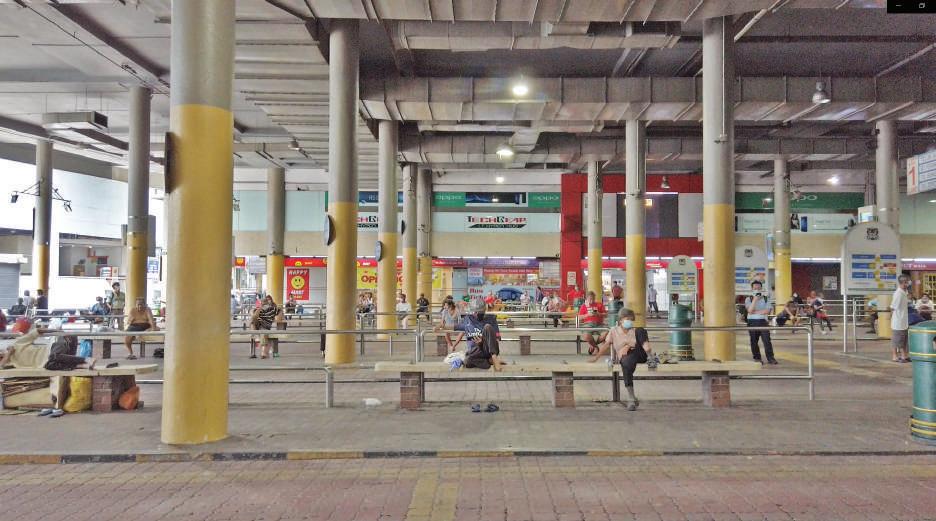
Everyone has someone in their lives who is well into their late 60s or older. It could be our grandparents, parents, relatives, neighbours,
– from their neighbourhood and society, the way we communicate, the cultural and consumption patterns, and many other modern aspects of life that our generation normalises today. But that does not necessarily mean that they are well caught up with the changes of time. An elderly person’s ability to live a dignified and independent life, while retaining their sense of self-identity and their connection to a place they feel belong to, has been largely excluded from the mainstream discussions on social
and even friends. However, the mainstream understanding of demography is often presented in analysis that reduces each individual into nameless and faceless data in the statistics. As a researcher with a background in city design and social science, I wanted to explore a more nuanced approach in identifying the struggles faced by the elderly population who are living in a highly urbanised society.
These generations of people were born in a very different era. They witnessed how rapidly the world has changed everything they used to know
inequality. This issue often finds itself competing for attention amidst other pressing concerns such as the increasing cost of living, unemployment, and the ever-rising rate of inflation.
In Malaysia, it is estimated that 3.5 million people are above the age of 65. They are also considered the most vulnerable group in terms of the ability to maintain a minimum standard of living until 77 years old. In a recent roundtable discussion on the future of pensions and social protection in Malaysia held by the Employees Provision Fund (EPF), it is projected that only about
Elderlies are often seen spending their time at public areas. Penang is currently the second highest ageing state in Malaysia after Perak, where almost 15% of Penang's 1.77 million population is 60 or older.4% of the Malaysian population can afford to retire well. This is a shocking statistic that we all should be very concerned about. The issue of ageing is serious, complex and multi-faceted, and the whole of society needs to realise that this isn’t just an “old people’s problem”. We must recognise that this is a glimpse of our future, and we should care about this even from today.
Ultimately, we need a more thoughtful, agefriendly city that takes into full consideration of a wide range of needs, such as making the city walkable and safe, or to ensure that access to good public health is always within reach, or providing affordable housing solutions to prevent homelessness and to ensure that cost of living and poverty doesn’t become a critical problem at old age.
I hope that people will see their grandparents, parents, friends, and neighbours and eventually see themselves too in this story. This is so that we can begin to truly understand and start conversations on why urbanisation should also cater to the most vulnerable, like the aged communities. We must reimagine a new normal that does not leave anyone behind.
I am truly grateful that this film has helped people visualize and reflect on how the urban environment we live in fundamentally determines how our future could look like. I intend to demystify city design for the general audience by making the issues relatable. Then only we can begin to

understand what and who is at stake and how we can do better. At each post-screening discussion, there will be audiences who shared their reflections and thoughts about the film – and offering ideas and wanting to also do something to make a change. As for the town and transport planners, architects, and policymakers, I hope this film will help them humanise the blueprints they draw and the policies they draft. We must always keep the ageing agenda on the table, simply because we cannot afford not to do so.
Lastly, I am grateful to my aunt for opening up her life to all of us through this short documentary. My journey in making this film has been a truly humbling experience, as I learned about her daily life and the struggles she faces, and the tenacity in her character that helps her get by each day. I wish it was possible to include much more from the countless hours of one-to-one conversations we had while making this film. Still, may this distilled story is enough to spark important conversations about the future we want when we age.
A discussion with the audience at the screening of Grey Scale at George Town Literature Festival, November 2022. After each screening, we have a discussion session with a panel of experts to talk about the current issues and work done around ageing and to engage with the audience on the concerns that they may have.


“Penang Hill” a hill commonly associated by most of us with hiking trails, funicular train, Flagstaff Hill, heritage bungalow and ais kacang. But those are not all the stories this former colonial hill station bears.
Penang Hill or locally known as Bukit Bendera is nature haven and the green lungs of Penang. It is also home to peoples of diverse backgrounds: from farmers and private residents, monks and the laypeople, caretakers and general workers. Besides its colourful heritage, Penang Hill story is not an easy one to unpack; there is its history which dates back to the 18th century cast against its current circumstance whose dilemmas are many, including the rise of tourism and climate change. Within those challenges are the many tales that remain untold.
 Text & photos provided by Wan Atikah bt Wan Yusof
Pinang taro soup by Ong Ke Shin / 2023
A photo from Guardians by Yeap Lee Hua / 2023
Text & photos provided by Wan Atikah bt Wan Yusof
Pinang taro soup by Ong Ke Shin / 2023
A photo from Guardians by Yeap Lee Hua / 2023


 One of the visual work by Oh Chin Eng in his series, “Ah Tniao”
One of the visual work by Oh Chin Eng in his series, “Ah Tniao”
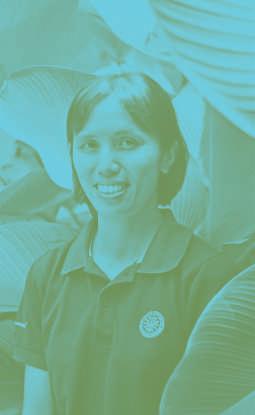

Through “A Tale of Two Hills”, a unique mentorship programme aimed at nurturing visual narrators to document natural heritage and cultural narratives of Malaysia’s earliest colonial hill stations, Penang Hill and Maxwell Hill, the 8 narrators, 4 for each location set out to capture the tale from the hill with the support and guidance from Jeffrey Lim, photography artist and cultural worker, anthropologist Wan Atikah bt Wan Yusof and author of “Beguiled On Larut Hills”, Liew Suet Fun.
The 4 narrators selected for Penang Hill came from diverse backgrounds and each of them are calling Penang as their home. They are: Yeap Lee Hua (Leaf), a cultural worker turns videographer; Ong Ke Shin, a geographer turns photographer, Oh Chin Eng, a local boy with a camera turns his shots into compelling visual narratives, and Foo Wei Meng, a behind-the-scenes community researcher cum photographer finally unveils her work. Through this program, they dive into their passion, curiosity and personal quest to tell the stories of Penang Hill.

After months of countless visits to the hill, fostering relationships with the hill and her people, brainstorming, ideation and production, the narrators’ work were put together as an exhibition. The exhibition showcases the work of these visual narrators and explores a wide range of topics ranging from sustainability, biodiversity, species endemicity to human society and the cultural impacts of colonialism, migrations and the inter-generational dynamics of communities living on and around the highlands.
 Yeap Lee Hua
Ong Ke Shin
Oh Chin Eng
Foo Wei Meng
A six-month mentorship programme
Yeap Lee Hua
Ong Ke Shin
Oh Chin Eng
Foo Wei Meng
A six-month mentorship programme

The exhibition by 8 narrators, 4 from each hill, took place simultaneously at their respective location. The Penang Hill exhibition is at Mano Plus, Lebuh Pantai. The Maxwell Hill exhibition is at Maxwell Basecamp, located at the foot of Bukit Larut. Both events ran for two weeks beginning 16th February in Penang and 17th February in Taiping. The exhibits are created by a corps of 8 visual narrators under a unique six-month mentorship programme that is supported by Habitat Foundation and Think City under the Northern Region Archaeotourism Network aimed at creating awareness of cultural and natural heritage and encouraging community based tourism and other related industries.
A Tale of Two Hills – Penang Hill Exhibition features “Behind the Blossom”, a debut documentary film by Yeap Lee Hua (Leaf), that tells the tale of the flower farmer on the hill and their struggles, caught in the throes between making a living and climate change, “People, Palate and Penang Hill” by Ong Ke Shin, which features reminiscences of vintage recipes is an evocation of the link between nature and nurture, “Ah Tniao” by Oh Chin Eng, that invites the viewer to reflect on the struggles and the connection between the hill and its residents, expressed in a tone of filial piety and personal attachment to the hill and lastly, “Are We There Yet?” by Foo Wei Meng that tell the story of hikers on Penang Hill through her visual work.


